
 wood - A
plant product, fibrous material
found as the primary content of the stems of such "woody"
plants as trees and shrubs. These perennial plants are characterized
by stems and branches that grow outward year after year, and that
are composed of cellulose
held together with lignin (also called xylum tissue), which
conducts sap upward from the roots to the leaves, stores food,
and provides support.
wood - A
plant product, fibrous material
found as the primary content of the stems of such "woody"
plants as trees and shrubs. These perennial plants are characterized
by stems and branches that grow outward year after year, and that
are composed of cellulose
held together with lignin (also called xylum tissue), which
conducts sap upward from the roots to the leaves, stores food,
and provides support.
 Annual new growth results in the development
of a ring of xylum added outside the rings produced in previous
years, and these are observable in cross-section. In temperate
regions, the light rings represent the rapid growth occuring each
spring; the darker rings the slower growth in the rest of the
year. The innermost wood in a tree's trunk is called the heartwood,
while the outermost is the functional sapwood.
Annual new growth results in the development
of a ring of xylum added outside the rings produced in previous
years, and these are observable in cross-section. In temperate
regions, the light rings represent the rapid growth occuring each
spring; the darker rings the slower growth in the rest of the
year. The innermost wood in a tree's trunk is called the heartwood,
while the outermost is the functional sapwood.
Because it provides such effective and efficient structural material for plants, wood has long proven useful to humans.
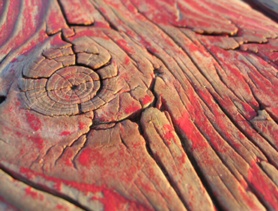 When cut down and dried, it is
used for many purposes:
When cut down and dried, it is
used for many purposes:
Wood that is broken down into fibers is called wood pulp, which can then be made into paper.
Wood can be cut (sawn), carved (chiseled, drilled, routered, turned, planed, filed, sanded, buffed and polished), joined (nailed, screwed, bolted, glued, etc.) by artists and craftsmen using special tools. This is called woodworking or carpentry. The majority of all wood is used in the construction of buildings. Extensions are cabinetry and furniture-making.
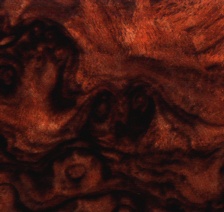 With more and more competing technologies, many of wood's
traditional uses can be
satisfied with cement,
metal, and plastics.
With more and more competing technologies, many of wood's
traditional uses can be
satisfied with cement,
metal, and plastics.
Wood is commonly classified as either hardwood or softwood. The wood from conifers (e.g., firs and pines) is called softwood, and the wood from broad-leaved trees (e.g., oak, cherry, walnut, mahogany) is called hardwood. This classification can be misleading, because some hardwoods (e.g., balsa) are actually softer than most softwoods.
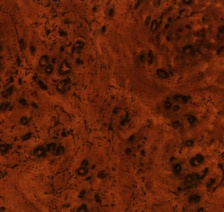 Woods from different types of
trees have different colors and grain densities. Because of these
differences, and the fact that some woods take longer to grow
than others, wood from different kinds of trees have different
qualities and market
values. For example, while mahogany is a dark, dense hardwood
which is excellent for fine furniture crafting, balsa is light,
soft, and almost spongelike, making it useful for model building.
Woods from different types of
trees have different colors and grain densities. Because of these
differences, and the fact that some woods take longer to grow
than others, wood from different kinds of trees have different
qualities and market
values. For example, while mahogany is a dark, dense hardwood
which is excellent for fine furniture crafting, balsa is light,
soft, and almost spongelike, making it useful for model building.
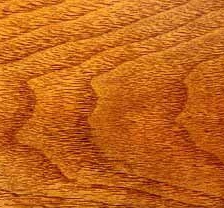 In the conifers the xylem is made
up mainly of tracheids, thus presenting a uniform, nonporous appearance;
their wood is called softwood. Deciduous trees have more complex
xylem, permeated by vessels, and are called hardwoods, although
the description is sometimes inaccurate.
In the conifers the xylem is made
up mainly of tracheids, thus presenting a uniform, nonporous appearance;
their wood is called softwood. Deciduous trees have more complex
xylem, permeated by vessels, and are called hardwoods, although
the description is sometimes inaccurate.
The word "wood" has come to us from the old Anglo-Saxon wudu. [I'd believe it. Wudu?]
Woods (those most commonly used to make things) :
alder (Alnus)
apple (Malus)
ash (Fraxinus) - See American Colonial art, furniture, and laminate
aspen, quaking (Populus tremula, Populus tremuloides)
balsa (Ochroma pyramidale) See hardwood.
basswood (Tilia americana)
beech (Fagus)
birch - See cane and caning, furniture, and laminate, and shard
boxwood (Buxus sempervirens) - See crucifix.
brazilwood (Caesalpinia echinata)
butternut (Juglans cinerea)
catalpa (Catalpa)
cedar - See polychromy, Spanish art, totem and totem pole, and ushabtis.
cherry, black (Prunus serotina) - See collage, furniture, hardwood, horology, lintel, movement, pedestal, post, screen, sculpture, and sculpture garden.
chestnut (Castanea dentata) - See American Colonial art, mehndi, Kunstkabinett and Kunstkammer, and Post-Impressionism.
corkwood (Leitneria floridana) - See collage and shadow box.
cottonwood, eastern (Populus deltoides)
cypress, southern (Taxodium distichum) - See Heian period and van Gogh in Post-Impressionism.
driftwood - (Whatever washes up!) - See assemblage, Dada, and stain.
ebony - See Baroque, crucifix, Egyptian art, g-gl, Kunstkabinett and Kunstkammer, marquetry, ormolu, Seven Wonders of the Ancient World, veneer, and vessel.
elm
eucalyptus
fir (Abies) - See furniture and softwood.
fruitwood (See individual fruit trees: apple, cherry, pear, etc.)
ginko - See earth art.
hemlock (Tsuga)
hickory
hornbeam (Carpinus species)
ironwood, black (Rhamnidium ferreum) -See Pre-Columbian art.
jacarandá, Brazilian rosewood (Dalbergia nigra)
kingwood - See marquetry.
laurel, California (Umbellularia californica) - See numismatics, postmodernism, and Roman art.
lime - See Northern Renaissance.
linden - See earth art and Northern Renaissance.
mahogany - See American Colonial art, American Indian art, Art Nouveau, design, furniture, hardwood, horology, kaleidoscope, landscape, marquetry, model, pedestal, stain.
maple (Acer) - See arms & armor, design, fig leaf, furniture, horology, laminate, stain.
oak (Quercus) - See American Colonial art, Art Nouveau, Barbizon school, Baroque, be-bimeissonier, crucifix, enlargement, furniture, German art, grotesque, hardwood, landscape, mirror, misericord, nature, ormolu, Pre-Columbian art, reliquary, rush, Scottish art, sculpture, sphere, stain.
olive - See Fauvism, van Goh in landscape and Post-Impressionism, and marquetry.
pear (Pyrus communis) - See earth art.
pecan - See stain.
pine (Pinus) - See American Colonial art, Baroque, design, furniture, galvanized, Islamic art, marquetry, polychromy, portrait, sculpture, softwood, Spanish art, stain, stretcher.
poplar - See American Colonial art, furniture, mirror, sculpture, and tondo.
rosewood, Brazilian / Jacarandá (Dalbergia nigra) - See furniture, inlay, marquetry, and veneer.
sycamore, American (Platanus occidentalis) - See earth art, furniture, and marquetry.
teak (Tectona grandis) - See screen.
tulipwood - See furniture, marquetry, and veneer.
walnut (Juglans) - See American Colonial art, design, frame, furniture, Kunstkabinett and Kunstkammer, marquetry, sculpture, and stain.
willow, black (Salix nigra) - See sculpture and volute.
yew - See furniture and topiary.
Examples of art made of wood:

Egypt, second century CE,
Hawara, Roman Period, Funerary Portrait of a Young Girl, encaustic on wood,
height 15 3/4 inches, Cleveland
Museum of Art. See Fayum portraits
and portrait.

Japan, Pagoda at Horyu-ji Buddhist temple complex,
c. 8th century, wood construction.
See Japanese
art and pagoda.

Attributed to Egypt, Fatimid, Wood panel, 11th century, carved
wood, 13 3/4 x 9 inches (34.93 x 22.9 cm), Metropolitan Museum
of Art, NY. See Islamic
art and volute.

China, Tea bowl stand, Southern Song
dynasty (1127-1279), brown lacquer
on wood and fabric, Asian Art Museum, San Francisco, CA.
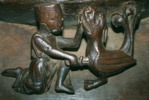
English, Knight Fighting a Dragon, carved
oak, one of the 35 misericords
at the cathedral of St.
Peter, Exeter, c. 1279. Three others are Branch Springing from a Dragon's Mouth,
Doves with Strawberry Leaf Between Them,
and the Locust of the Apocalypse.

Giotto di Bondone (Italian, Florentine, 1266/76-1337),
The Epiphany, possibly c. 1320, tempera
on wood, gold
ground, 17 3/4 x 17 1/4
inches (45.1 x 43.8 cm), Metropolitan Museum of Art, NY. (On
the Met's page, you can enlarge any detail.) See perspective.
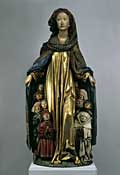
Germany, Ravensburg, probably Friedrich Schramm,
c. 1480, Virgin
Mary with the Protective Cloak, polychromed
linden wood, height 135
cm, Bodemuseum, Berlin. See Madonna
and Northern
Renaissance.
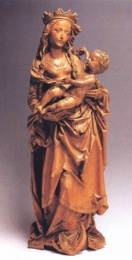
Tilman Riemenschneider (German, c. 1460-1531), Madonna and Child, carved linden wood.

Gerard David (Netherlandish, born about 1455,
died 1523), The Rest on the Flight into Egypt, c.
1512-15, oil on wood panel, 20 x 17 inches (50.8 x 43.2
cm), Metropolitan Museum of Art, NY. The inclusion of a vignette
of the Holy Family emerging from the forest allows this painting
to provide a continuous narrative.
See chiaroscuro, drapery,
and Northern
Renaissance.
Leonardo da Vinci (Italian, 1452-1519), Mona Lisa (La Joconde), c. 1503-1506, oil on wood panel, 77 x 53 cm, Louvre. Paintings in Europe during the Middle Ages were most often painted on wood panels or in stucco, and although Leonardo in reknowned as a great innovator, he was faithful to the wood panel tradition with few exceptions. This famous portrait is important for several reasons, including his use of sfumato. It seems to suggest that we are observing this face as its expression is changing. The picture also presents early examples of aerial perspective and landscape painting.

Although painters still paint on wood panels, from the time of the Renaissance,
they have produced far more paintings on canvases
mounted on wooden stretchers.
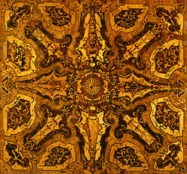

German, Floor, c. 1715-1720, pine, marquetry
with kingwood, bois satiné, sycamore, tulipwood, and olive,
9 feet 11 inches x 10 feet 11 inches, Getty Museum, Malibu, CA.
Detail:
c. 3 x 3 feet.
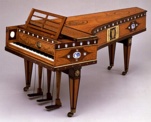
John Broadwood and Son, piano designer (English,
active 1795-1808), with cameos and medallions designed by Josiah
Wedgwood (1730-1795), case decoration by Thomas Sheraton (1751-1806),
Grand Piano, 1796, veneered
case of satinwood, tulipwood, and purpleheart with Wedgwood cameos and medallions;
piano: 97 7/8 x 43 7/8 x 35 7/8 inches (248.7 x 111.5 x 91.2
cm), Wedgwood medallion: c. 3 inches across (7.6
cm), Museum of Fine Arts, Boston.

Naito Toyomasa (Japanese), Netsuke, late 18th - mid-19th century,
wood, 3.3 x 3.1 cm, Hermitage Museum, St. Petersburg, Russia.
See netsuke.
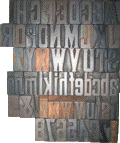
Page and Setchell Company (American), one
of this company's seventeen styles
of type, 1887, die-cut
wood.

Africa, Zaïre, Yombe or Woyo, Fetish, wood, nails,
metal fragments, small
chain, traces of polychrome,
97.5 x 47 x 28 cm, Georges Pompidou Center, Paris. See fetish.

Charles Rennie Mackintosh (Scottish, 1868-1928),
designer, Hill House Chair, 1904, black lacquered
wood with upholstered seat,
55 x 16 x 14 1/4 inches. See Arts
and Crafts Movement and vertical.

Elie Nadelman (American, born Poland, 1882-1946),
Dancer, c. 1918-1919, cherrywood, Jewish
Museum, NY. See curvilinear,
Jewish art, and sculpture.

Karl Schmidt-Rottluff (German, 1884-1976),
Male Head, 1917, wood, 34.3 x 13.3 x
16.5 cm, Tate Gallery, London.

New Guinea,
Asmat people, on the island of Irian Jaya, between the Asewetsj
and Siretsj rivers, Bis Poles, 20th century, mangrove wood,
lime, charcoal, ochre,
and fiber, height
10-18 feet (548.6 cm), Metropolitan Museum of Art, NY. The Asmat
used these poles in ritual feasts and to honor the dead at "bis"
ceremonies. (pr. biss)
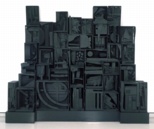
Louise Nevelson (American, born Russia, 1899/1900-1988),
Sky
Cathedral, 1958, found
wood assemblage sculpture,
painted black, 115 x 135 x 20 inches, Albright-Knox Art Gallery,
NY. See feminist art.
![]()
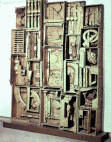
Louise Nevelson, Royal Tide V, l961,
found wood assemblage
sculpture.
Joseph Cornell (American, 1903-1972), Celestial Navigation, n.d., shadow box construction with wood, glasses, marbles, plaster head, painted cork ball, metal rods, nails, paper collage, tempera, and painted glass, 9 5/8 x 16 1/4 x 4 inches (24.4. x 41.3 x 10.2 cm), Whitney Museum of American Art, NY. See sculpture and Surrealism.

Elizabeth Catlett (American, 1919-), Ife, 2002, carved mahogany, Chrysler Museum of Art, Norfolk, VA. See African American art and nude.

Karel Appel (Dutch, 1921-2006), Questioning Children (Vragende kinderen),
1948, relief:
pieces of wood nailed onto a wooden
panel, painted with oil,
85 x 56 cm, Georges Pompidou Center, Paris. See Cobra.
![]()



Details of three contemporary
parquet floors, each about
4 x 5 feet.
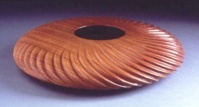
William Hunter (American, contemporary), Autumn Flutes, 1982, lathe carved vinhatico, 2 1/8 x 10 9/16 x 10 9/16 inches, ASU Art Museum, Tempe, AZ.
![]()
Georg Baselitz (German, 1938-), Untitled, 1982-3, painted wood (lime),
250.0 x 73.0 x 59.0 cm, Tate Modern, London. Although Baselitz
is considered a Neo-Expressionist,
the rough surfaces of
earlier German Expressionism
can be seen in this partially chainsawed sculpture carved
from a tree trunk.

Martin Puryear (American, 1941-), Vault, 1984, wood, wire
mesh, and tar, 66 x 97 x 48 inches, Museum of Contemporary Art,
San Diego, CA. See African American art and Post-Minimalism.

Martin Puryear, Lever No. 3, 1989, carved
and painted wood, National Gallery of Art, Washington, DC.
Robert Gober (American, 1954-), Untitled, 1984, plaster, wood, wire lath, aluminum, watercolor, semi-gloss enamel paint, collection of the artist, NY.

Robert Gober, X Playpen, 1987, wood construction.

Andy Goldsworthy (English, 1956-), one of
Two
Oak Stacks, 2003, two large balls of stacked and knitted
oak sticks, Storm King Art Center. This ball of sticks is (or
was) directly outside the museum building, visible through the
window of the gallery
where the other identical ball of sticks was constructed and
exhibited. See earth
art, ephemera, and
sphere.

Andy Goldsworthy, Stone Houses, 2004, two monumental
domes constructed
of wood (split rails from New England agricultural sources) and
stone (from Scotland),
each 18 feet in height and
24 feet in diameter, Metropolitan
Museum, NY. This installation
is in the museum's Roof Garden, an outdoor space for sculpture
with a great view of the city. The museum says the work was "inspired by Central Park
and its architectural
backdrop. Inherent in these seemingly simple forms
are the implicit power, beauty,
mystery, and elemental
aspects of nature,
marked by the passage of time
and by human contact." See sculpture
garden.
Also see abrasive, acid, acid free, adobe, adze, assemblage sculpture, basketry, bonsai, butt joint, carving, charcoal, chisel, circular saw, crosscut saw, dowel, file, finish, frame, gouge, hacksaw, helix, hollow carving, Inlay, intarsia, join, kerf, leather, marquetry, maul, miter, mortise, nail, papermaking, parquetry, polyurethane, rasp, relief printing, resin, riffler, seasoning, spatula, spokeshave, stain, staple, stretcher, surform, tenon, turpentine, varnish, veneer, wood, woodcut, and wood engraving.
https://inform.quest/_art